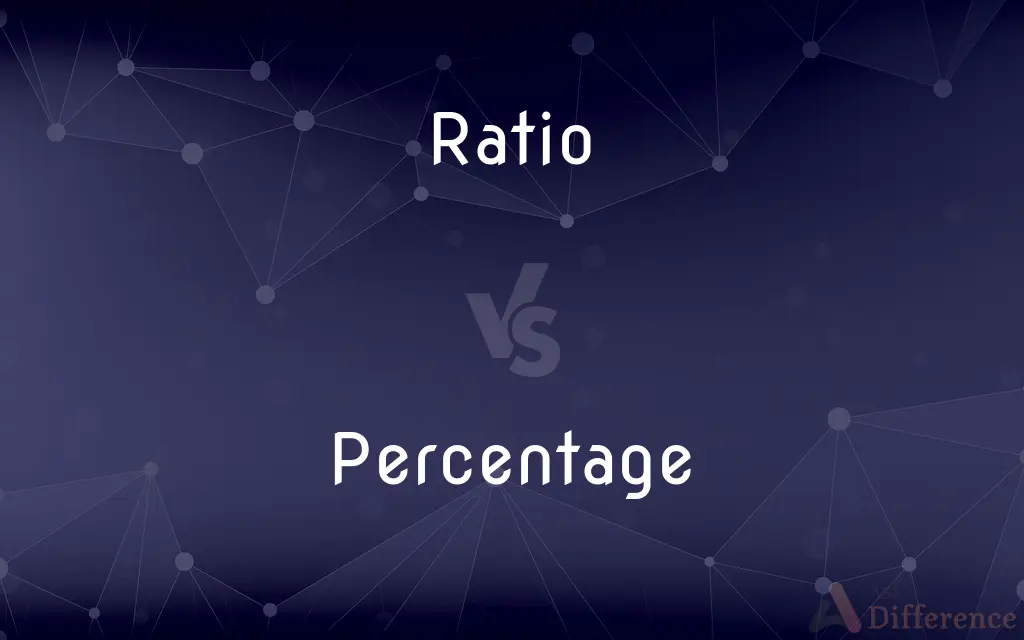Ratio vs. Percentage — What's the Difference?
Edited by Tayyaba Rehman — By Fiza Rafique — Updated on November 2, 2023
A ratio compares two quantities, while a percentage shows a part per hundred of a whole.

Difference Between Ratio and Percentage
Table of Contents
ADVERTISEMENT
Key Differences
A ratio is a quantitative relationship between two numbers showing how many times one value contains or is contained within the other. Ratios can be expressed in various forms such as 3:2, 3 to 2, or as a fraction 3/2. A percentage, on the other hand, represents a ratio as a fraction of 100, denoting a part of a whole as hundredths. It is specifically a comparison to the total of 100, using the symbol %.
Ratios are dimensionless and provide relative sizes of two or more values. They do not inherently express a part of a whole unless the two parts are components of a total. Percentages directly express how large one quantity is in relation to another quantity assumed to be 100. For example, if there are 20 apples out of 100 fruits, this can be represented by the ratio 20:100 or the percentage 20%.
In ratios, the total of the quantities being compared does not have to be 100. Ratios provide a way to express the scale between any two values, irrespective of the whole. Conversely, a percentage is inherently connected to a total implied to be 100, which is convenient for expressing fractions of a whole in a standardized form that is easily understood and compared.
Ratios are often used in various fields, including mathematics, engineering, and cooking, to maintain proportionality. Percentages are commonly used in finance, statistics, and to express probability, often when it is necessary to have a clear understanding of the relationship between a part and a whole as a standard base of 100.
Ratios and percentages are related concepts; a percentage can be converted into a ratio by dividing the percentage by 100. For instance, a 50% grade slope can also be described as a ratio of 1:2, indicating that for every unit of height, there are two units of horizontal distance.
ADVERTISEMENT
Comparison Chart
Basic Definition
Comparison between two numbers.
A part per hundred of a whole.
Expression Form
Can be written as x:y, x to y, or x/y.
Written as a number followed by %.
Total Reference
Does not require a total of 100.
Implies a total of 100.
Usage Contexts
Maintaining proportionality.
Expressing fractions as hundredths.
Conversion
No standard conversion; depends on context.
Convertible to a fraction or ratio by dividing by 100.
Compare with Definitions
Ratio
A comparative figure indicating the proportion of quantities.
The gender ratio at the event was 3 women to every 2 men.
Percentage
A way to express probability or parts per hundred.
There's a 25% chance of rain tomorrow.
Ratio
A fraction representing the relationship between two different numbers.
She mixed the drink in a ratio of 1 part soda to 2 parts juice.
Percentage
A percentage quantifies a number as a fraction of 100.
He scored 90% on his math test.
Ratio
A mathematical expression of one quantity to another.
The screen has an aspect ratio of 16:9.
Percentage
Used to describe rates, like interest and growth, relative to 100.
The bank offers an interest rate of 3% per annum.
Ratio
Ratios quantify the magnitude of one value versus another.
The company's debt-to-equity ratio has increased this quarter.
Percentage
Represents what portion of a whole is being described.
About 60% of the human body is water.
Ratio
A ratio shows the relative size of two or more values.
The ratio of flour to sugar is 2:1 in the recipe.
Percentage
In mathematics, a percentage (from Latin per centum "by a hundred") is a number or ratio expressed as a fraction of 100. It is often denoted using the percent sign, "%", although the abbreviations "pct.", "pct" and sometimes "pc" are also used.
Ratio
In mathematics, a ratio indicates how many times one number contains another. For example, if there are eight oranges and six lemons in a bowl of fruit, then the ratio of oranges to lemons is eight to six (that is, 8∶6, which is equivalent to the ratio 4∶3).
Percentage
A rate, number, or amount in each hundred
A large percentage increase
The percentage of Caesareans at the hospital was three per cent higher than the national average
Ratio
The quantitative relation between two amounts showing the number of times one value contains or is contained within the other
The ratio of men's jobs to women's is 8 to 1
Percentage
A fraction or ratio with 100 understood as the denominator; for example, 0.98 equals a percentage of 98.
Ratio
Relation in degree or number between two similar things.
Percentage
The result obtained by multiplying a quantity by a percent.
Ratio
The relative value of silver and gold in a currency system that is bimetallic.
Percentage
A proportion or share in relation to a whole; a part
The hecklers constituted only a small percentage of the audience.
Ratio
(Mathematics) A relationship between two quantities, normally expressed as the quotient of one divided by the other; for example, the ratio of 7 to 4 can be written 7:4 or 7/4. A ratio can often also be expressed as a decimal or percentage.
Percentage
An amount, such as an allowance, duty, or commission, that varies in proportion to a larger sum, such as total sales
Work for a percentage.
Ratio
A number representing a comparison between two named things.
Percentage
(Informal) Advantage; gain
There is no percentage in work without pay.
Ratio
(arithmetic) The relative magnitudes of two quantities (usually expressed as a quotient).
Percentage
The amount, number or rate of something, regarded as part of a total of 100; a part of a whole.
A high percentage of secondary school leavers take a gap year.
Ratio
(legal) ratio decidendi
Percentage
A share of the sales, profits, gross margin or similar.
She gets a percentage for every vacuum cleaner sold.
Ratio
(Internet) The number of comments to a post or other expression on social media relative to the number of likes; a high ratio suggests disagreement with the contents of the original post.
Percentage
(informal) Benefit or advantage.
There was no percentage in staying at home.
Ratio
To respond to a post or message on social media in a greater number than the number of likes the post receives, especially to condemn or mock the original poster.
The politician's post was quickly ratioed due to its controversial nature.
Percentage
A certain rate per cent; the allowance, duty, rate of interest, discount, or commission, on a hundred.
Ratio
Indicates disagreement with a post the user disagrees with or dislikes.
L + ratio
Percentage
A proportion multiplied by 100
Ratio
The relation which one quantity or magnitude has to another of the same kind. It is expressed by the quotient of the division of the first by the second; thus, the ratio of 3 to 6 is expressed by
Percentage
Assets belonging to or due to or contributed by an individual person or group;
He wanted his share in cash
Ratio
Hence, fixed relation of number, quantity, or degree; rate; proportion; as, the ratio of representation in Congress.
Percentage
Percentage indicates how many hundredths of something is being represented.
The company reported a 10% increase in revenue.
Ratio
The relative magnitudes of two quantities (usually expressed as a quotient)
Common Curiosities
Is a percentage a type of ratio?
Yes, a percentage is a specific type of ratio with a denominator of 100.
Can ratios be used to compare more than two quantities?
Yes, ratios can compare multiple quantities, e.g., 2:3:4.
Is a ratio always less than 1?
No, a ratio can be any positive number, depending on the quantities compared.
How do you find the percentage of a number?
Multiply the number by the percentage and then divide by 100.
How do you convert a ratio to a percentage?
Multiply the fraction form of the ratio by 100 to get the percentage.
Are ratios scale-invariant?
Yes, the same ratio can describe different sizes of the same relationship.
Can percentages exceed 100?
Yes, percentages can exceed 100 if the value represents more than the whole.
Can percentage be converted into decimal?
Yes, by dividing the percentage by 100.
How are percentages commonly used in finance?
Percentages represent interest rates, profit margins, and investment returns.
What does a ratio of 1:1 mean?
It means the two quantities are equal.
Do percentages need to be normalized?
Percentages are already normalized to a base of 100.
What is a unit ratio?
A unit ratio is a ratio where the second term is 1, showing the amount per one unit.
Are ratios dimensionless?
Yes, ratios do not have units and are considered dimensionless.
When should I use ratio instead of percentage?
Use ratios for direct comparisons and when the whole is not relevant or not 100.
Why is it important to understand percentages?
Understanding percentages is key for financial literacy, data interpretation, and expressing proportions consistently.
Share Your Discovery

Previous Comparison
Bargain vs. Discount
Next Comparison
Problematic vs. ProblematicalAuthor Spotlight
Written by
Fiza RafiqueFiza Rafique is a skilled content writer at AskDifference.com, where she meticulously refines and enhances written pieces. Drawing from her vast editorial expertise, Fiza ensures clarity, accuracy, and precision in every article. Passionate about language, she continually seeks to elevate the quality of content for readers worldwide.
Edited by
Tayyaba RehmanTayyaba Rehman is a distinguished writer, currently serving as a primary contributor to askdifference.com. As a researcher in semantics and etymology, Tayyaba's passion for the complexity of languages and their distinctions has found a perfect home on the platform. Tayyaba delves into the intricacies of language, distinguishing between commonly confused words and phrases, thereby providing clarity for readers worldwide.














































